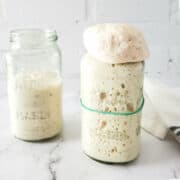Sourdough Starter Recipe
A sourdough starter is a natural leavening agent cultivated from a symbiotic culture of wild yeasts and lactic acid bacteria. Unlike commercial yeast, which produces a single-note flavor, sourdough starter introduces a delightful tanginess and complex flavor profile to your bread.
Servings: 1 starter
Calories: 226kcal
Ingredients
Day 1
- ½ cup Unbleached flour
- ½ cup Water
Day 3
- ½ Unbleached flour
- ½ Water
Feeding and Maintaining
- Unbleached flour per feeding requirements
- Water per feeding requirements
Instructions
- In a clean, non-reactive container (like a glass jar), combine the flour and water. Mix well to form a shaggy dough.½ cup Unbleached flour, ½ cup Water
- Cover the jar loosely with a lid or cloth (not airtight) and leave it at room temperature (around 70°F/21°C) for 48 hours.
- After 48 hours, discard half of the starter and discard the liquid on top. Feed the remaining starter with another ½ cup (65g) of flour and ½ cup (120ml) of water. Mix well and cover loosely again.½ Unbleached flour, ½ Water
- Place a heavy rubber band around the jar and move it (a little water helps) to the very top of the new sourdough starter. The rubber band is your bench mark to see how fast and how high the new starter is growing.
- Repeat step 3 (discarding half and feeding with fresh flour and water) every 12 hours for 5-7 days. You should start to see visible signs of activity, with bubbles appearing on the surface of the starter.Unbleached flour, Water
- Your starter is ready to use when it doubles in size within 4-6 hours after feeding. A test is to take a spoonful of starter and drop it into a bowl of water. If it floats, your starter is active and ready for use!
- Always use starter for breadmaking when it's at the bubbliest point.
Notes
- Be patient! Developing a healthy sourdough starter takes time and consistency. Don't get discouraged if you don't see immediate results.
- Use room temperature water. Hot water can kill the wild yeasts.
- Choose a warm spot. A consistent temperature around 70°F/21°C is ideal for starter development.
- Use a loose cover. The starter needs to breathe, so avoid using an airtight lid.
- Don't over-discard. When discarding half the starter, make sure you leave enough (about ½ cup) to feed with fresh flour and water.
- Hooch Topped Starter: If you see separation, where a liquid floats on top of the starter, just mix it in and feed the starter. That water floating means the starter needs to be fed.
Nutrition
Calories: 226kcal | Carbohydrates: 45g | Protein: 7g | Fat: 1g | Saturated Fat: 0.1g | Polyunsaturated Fat: 0.5g | Monounsaturated Fat: 0.1g | Sodium: 7mg | Potassium: 63mg | Fiber: 2g | Sugar: 0.2g | Vitamin A: 1IU | Calcium: 13mg | Iron: 1mg
